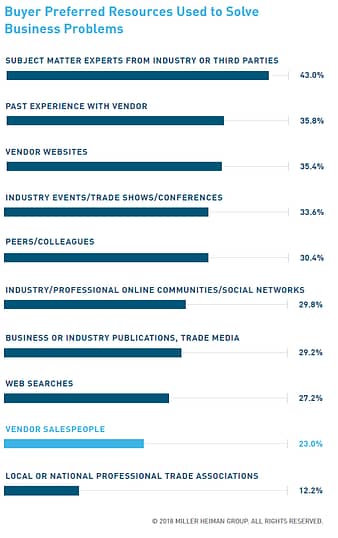“Are Salespeople Relevant to the Modern Buyer?” is the question posed in an article by Tamara Schenck about about CSO Insights’ 2018 Buyer Preferences Study. At first glance, its results seem to say “Not really.” Most buyers only engage with salespeople after they have identified their needs. Many buyers have already identified a solution before engaging with sales. So, what are the implications for sales communication content, and for video content in sales communication in particular?
Salespeople are playing catchup

Schenk’s most telling point is that the later salespeople are engaged, the more they have to catch up. Differentiation becomes difficult because “there is less time and space to inspire with creativity.”
What can inspire with creativity? Well, there’s often a great deal of creativity packed in blog articles, white papers, research reports and the like — traditional mid- and late-funnel content. But it may go unshared. It may go unnoticed because buyers never see this content or don’t immediately recognize its relevance.
Sales enablement: the case for video in sales communication
Sales enablement programs, Schenk argues, should ensure that salespeople have individualized “value messages” — inspiring ideas about the buyer’s issues — for each phase of the customer’s path, and relevant to buyer roles and industries.
That’s a tall order, but it helps make the case for video in sales communication. After all, not everyone needs to read the complete article or white paper to be inspired by its best ideas. Video is one of the two most effective content types later in the sales process, according to sales enablement research by Seismic’s SAVO Group. The other is case studies. And video makes it easy for a champion to share information as part of an internal evangelization effort. (Here’s a ~30-second video that makes the case for sharing videos later in the sales process.)
Research reports are typical “mid-funnel” content. Here’s an example from a series of videos based on a 451 Research report. The TechTarget campaign featuring these videos got 3X the industry average response. As you’ll see, the video is more of an argument than a product pitch.
Just one differentiator
I’m a fan of the one-thing-to-remember-you-by approach when differentiation is difficult, as it is late in the sales process. And if that one thing can be expressed in a chart or illustration, so much the better, because you can make a shareable video out of it. There’s some fascinating academic research indicating that charts change hearts and minds better than words do. The study finds that charts are vastly more effective in eliminating firmly held “misperceptions” than text. In fact, in one experiment, viewing a chart led most people to admit they’d been mistaken, while reading data as text content increased the misperceptions. So look for the visual that makes your point with clout — and build a powerful piece of video for sales communication around it.




